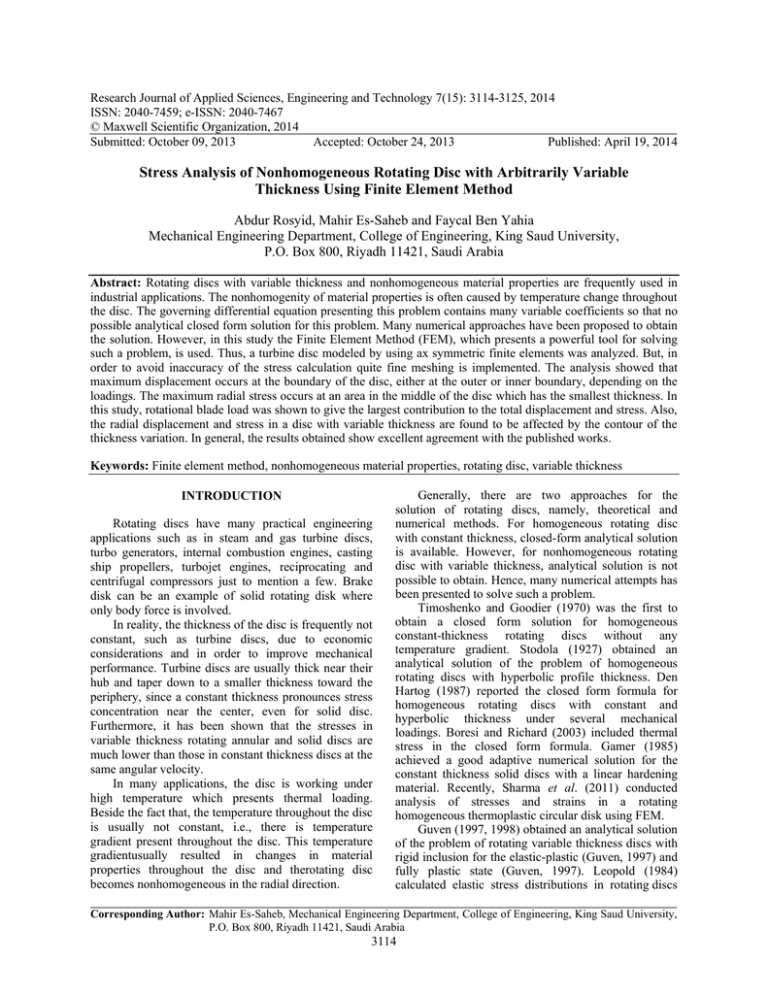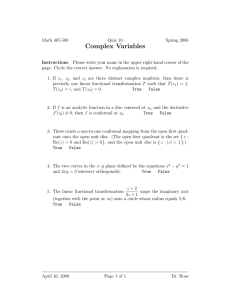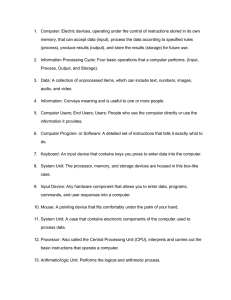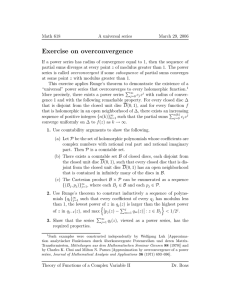Research Journal of Applied Sciences, Engineering and Technology 7(15): 3114-3125,... ISSN: 2040-7459; e-ISSN: 2040-7467
advertisement

Research Journal of Applied Sciences, Engineering and Technology 7(15): 3114-3125, 2014
ISSN: 2040-7459; e-ISSN: 2040-7467
© Maxwell Scientific Organization, 2014
Submitted: October 09, 2013
Accepted: October 24, 2013
Published: April 19, 2014
Stress Analysis of Nonhomogeneous Rotating Disc with Arbitrarily Variable
Thickness Using Finite Element Method
Abdur Rosyid, Mahir Es-Saheb and Faycal Ben Yahia
Mechanical Engineering Department, College of Engineering, King Saud University,
P.O. Box 800, Riyadh 11421, Saudi Arabia
Abstract: Rotating discs with variable thickness and nonhomogeneous material properties are frequently used in
industrial applications. The nonhomogenity of material properties is often caused by temperature change throughout
the disc. The governing differential equation presenting this problem contains many variable coefficients so that no
possible analytical closed form solution for this problem. Many numerical approaches have been proposed to obtain
the solution. However, in this study the Finite Element Method (FEM), which presents a powerful tool for solving
such a problem, is used. Thus, a turbine disc modeled by using ax symmetric finite elements was analyzed. But, in
order to avoid inaccuracy of the stress calculation quite fine meshing is implemented. The analysis showed that
maximum displacement occurs at the boundary of the disc, either at the outer or inner boundary, depending on the
loadings. The maximum radial stress occurs at an area in the middle of the disc which has the smallest thickness. In
this study, rotational blade load was shown to give the largest contribution to the total displacement and stress. Also,
the radial displacement and stress in a disc with variable thickness are found to be affected by the contour of the
thickness variation. In general, the results obtained show excellent agreement with the published works.
Keywords: Finite element method, nonhomogeneous material properties, rotating disc, variable thickness
INTRODUCTION
Rotating discs have many practical engineering
applications such as in steam and gas turbine discs,
turbo generators, internal combustion engines, casting
ship propellers, turbojet engines, reciprocating and
centrifugal compressors just to mention a few. Brake
disk can be an example of solid rotating disk where
only body force is involved.
In reality, the thickness of the disc is frequently not
constant, such as turbine discs, due to economic
considerations and in order to improve mechanical
performance. Turbine discs are usually thick near their
hub and taper down to a smaller thickness toward the
periphery, since a constant thickness pronounces stress
concentration near the center, even for solid disc.
Furthermore, it has been shown that the stresses in
variable thickness rotating annular and solid discs are
much lower than those in constant thickness discs at the
same angular velocity.
In many applications, the disc is working under
high temperature which presents thermal loading.
Beside the fact that, the temperature throughout the disc
is usually not constant, i.e., there is temperature
gradient present throughout the disc. This temperature
gradientusually resulted in changes in material
properties throughout the disc and therotating disc
becomes nonhomogeneous in the radial direction.
Generally, there are two approaches for the
solution of rotating discs, namely, theoretical and
numerical methods. For homogeneous rotating disc
with constant thickness, closed-form analytical solution
is available. However, for nonhomogeneous rotating
disc with variable thickness, analytical solution is not
possible to obtain. Hence, many numerical attempts has
been presented to solve such a problem.
Timoshenko and Goodier (1970) was the first to
obtain a closed form solution for homogeneous
constant-thickness rotating discs without any
temperature gradient. Stodola (1927) obtained an
analytical solution of the problem of homogeneous
rotating discs with hyperbolic profile thickness. Den
Hartog (1987) reported the closed form formula for
homogeneous rotating discs with constant and
hyperbolic thickness under several mechanical
loadings. Boresi and Richard (2003) included thermal
stress in the closed form formula. Gamer (1985)
achieved a good adaptive numerical solution for the
constant thickness solid discs with a linear hardening
material. Recently, Sharma et al. (2011) conducted
analysis of stresses and strains in a rotating
homogeneous thermoplastic circular disk using FEM.
Guven (1997, 1998) obtained an analytical solution
of the problem of rotating variable thickness discs with
rigid inclusion for the elastic-plastic (Guven, 1997) and
fully plastic state (Guven, 1997). Leopold (1984)
calculated elastic stress distributions in rotating discs
Corresponding Author: Mahir Es-Saheb, Mechanical Engineering Department, College of Engineering, King Saud University,
P.O. Box 800, Riyadh 11421, Saudi Arabia
3114
Res. J. App. Sci. Eng. Technol., 7(15): 3114-3125, 2014
withvariable thickness by using a semi-graphical
method. Later, semi-analytical analysis of Functionally
Graded Materials (FGM) rotating discs with variable
thickness was proposed by Bayat et al. (2008). Hojjati
and Jaffari (2007) proposed Variation Iteration Method
(VIM) to obtain the elastic analysis of non-uniform
thickness and density rotating discs subjected to only
centrifugal loadings. However, You et al. (2000)
proposed numerical analysis using Runge-Kutta method
compared to FEM for elastic-plastic rotating discs with
arbitrary variable thickness and density. Likewise,
Hojjati and Hassani (2008) proposed Variablematerial
Properties (VMP) method and numerical analysis using
Runge Kutta’s method compared to FEMfor rotating
discs of non-uniform thickness and density. Recently,
they also proposed semi-exact solution for thermomechanical analysis of FGM elastic-strain hardening
rotating discs (Hassani et al., 2012). Furthermore, to
solve nonhomogeneous rotating disc with variable
thickness, Jahed et al. (2005) proposed discretization of
the disc into a finite number of rings, where each ring
has constant thickness and material properties, but
different rings may have different thickness and
material properties.
In this study, therefore, the problem of
nonhomogeneous rotating disc with arbitrarily variable
thicknessis addressed and other related issues are
discussed and presented. It is demonstrated that the
analytical solution for such a problem is not possible to
be obtained. Consequently, to solve this problem the FE
technique is used. The complete details of the FE
formulation and analysis of the problemalong with
numerical examples to verify the solution are presented
in the next sections.
Fig. 1: Infinitesimal element of the disc
Fig. 2: Displacements in infinitesimal element of the disc
σ − σt γ 2
dσ
1 dh
0
+ ω r=
σr + r + r
h dr
dr
r
g
(2)
Because the problem is axisymmetric, stress
components in tangential direction vanish:
σ t cos
METHODOLOGY
dθ
dθ
(3)
drdh − σ t cos
drdh =
0
2
2
Compatibility: Displacaments occurs in the disc is
Analytical solution for elastic nonhomogeneous disc
shown in Fig. 2. The compatibility ends up with strainwith variable thickness under mechanical and
displacement
relation as follows:
thermal loading: The problem can be considered as
plane stress with variable thickness. Hence, σ z = 0, as
du
this is a static problem, the solution has to satisfy
dr − u
u +
du
dr
equilibrium, compatibility and constituve law of =
the
(4)
εr
=
dr
dr
material properties.
( r + u ) d θ − rd θ u
Equilibrium: Assuming that the weight of the disc=
is
(5)
εt =
neglected, equilibrium of infinitesimal element of the
rd θ
r
disc, as shown in Fig. 1, in the radial direction is:
Properties of material, which are expressed by
𝑑𝑑𝑑𝑑
constitutive law of material: Because the problem is
𝜎𝜎𝑟𝑟 (𝑟𝑟𝑟𝑟𝑟𝑟𝑟𝑟ℎ) + 2𝜎𝜎𝑡𝑡 𝑠𝑠𝑠𝑠𝑠𝑠 𝑑𝑑𝑑𝑑𝑑𝑑ℎ −
2
elastic, Hooke’s law is used to get the stress-strain
𝑑𝑑𝑑𝑑𝑑𝑑
𝛾𝛾
�𝜎𝜎𝑟𝑟 +
𝑑𝑑𝑑𝑑� (𝑟𝑟 + 𝑑𝑑𝑑𝑑)𝑑𝑑𝑑𝑑 + 𝜔𝜔2 𝑟𝑟
relation.
𝑑𝑑𝑑𝑑
𝑟𝑟
Due to only mechanical loading and σ z = 0:
(𝑟𝑟𝑟𝑟𝑟𝑟𝑟𝑟𝑟𝑟𝑟𝑟ℎ) = 0
(1)
By simplification and taking sin (dθ/2) = dθ/2 due
to small angle Ө, we obtained:
3115
=
εr
1
(σ r −νσ t )
E
(6)
Res. J. App. Sci. Eng. Technol., 7(15): 3114-3125, 2014
=
εt
1
(σ t −νσ r )
E
(7)
Because there is also thermal loading; then,
ε=
ε elastic + ε thermal
total
Now subtituting Eq. (29) and (31) into (2), which is
the equilibrium equation in radial direction, we
obtained a second order Ordinary Differential Equation
(ODE) of the form:
d 2u
du
+f1
+ f 2u =
f3
2
dr
dr
(8)
and
where,
ε thermal = αT
(9)
f 1=
Hence, the total strains become:
1 d
+
r dr
hE
ln
2
1 −ν
εr =
1
(σ r −νσ t ) + αT
E
(10)
1 ν d
hE
− 2+
f2 =
ln
r
r dr 1 −ν 2
εt =
1
(σ t −νσ r ) + αT
E
(11)
=
f3
(12)
and
σ t = E ε t +νσ r − E αT
(13)
Subtituting Eq. (13) into (12) to get σ r :
σr
=
E
E αT
(ε r +νε t ) −
1 −ν 2
1 −ν
(14)
Now subtituting Eq. (12) in to (13) to get σ t :
σt
=
E
E αT
(ε t +νε r ) −
1 −ν 2
1 −ν
(15)
Subtituting Eq. (4) and (5) into (14) we get:
=
σr
E
1 −ν 2
=
σr
E
1 −ν 2
u E αT
du
+ν −
r 1 −ν
dr
u
du
+ ν − (1 + ν ) αT
dr
r
(16)
(17)
Similarly, substituting Eq. (4) and (5) into (15) we get:
σ=
t
=
σt
d
1 −ν 2 2
d hE
γω r + (1 +ν ) αT ln
(1 +ν ) αT ) −
(
dr
Eg
dr 1 −ν 2
(20)
The coefficients of the ODE contain variable
parameters:
Re-arranging Eq. (10) and (11), we get:
σ r = E ε r + νσ t − E αT
1 dν
+
r dr
E u
du E αT
+ν
−
dr 1 −ν
1 −ν 2 r
(18)
E u
du
− (1 + ν ) αT
+ν
dr
1 −ν 2 r
(19)
=
r , h h=
(r ), E E=
(r ),ν ν=
(r ), α α=
(r ), γ γ=
(r ),T T (r )
Because the coefficients of the ODE contain many
variable parameters, there are no exact solutions for this
ODE. However, as stated earlier, there have been
numerous numerical approaches to solve such a
problem. But in this study, the FE approach is utilized.
The details of the FE analysis and solution are
presented below.
Fem solution for elastic nonhomogeneous disc with
variable thickness under mechanical and thermal
loading: FEM is one of the most successful and
dominant numerical method in the last century. It is
extensively used in modeling and simulation of
engineering and science due to its versatility for
complex geometries of solids and structures and its
flexibility for many non-linear problems.
Most discs with variable thickness in the
applications are ax symmetric. For such a case, ax
symmetric element is the most economical but adequate
to use in the finite element analysis. For any other cases
in which the disc is not ax symmetric and therefore not
adequate to be modeled by axisymmetric element,
cyclic element and 3D solid element can be used.
The axisymmetric symmetric element has 2
translational degrees of freedom per node. Using
cylindrical coordinate system where z is the axis, r is
the radius and Ө is the circumference angle, the stresses
in the axisymmetric problem is shown in Fig. 3.
Internal and external pressure working at the inner
and outer surface of the disc are surface forces. The
element surface force vector is given by:
3116
Res. J. App. Sci. Eng. Technol., 7(15): 3114-3125, 2014
Fig. 4: A half cross sectional view of the disc with
dimensions in mm
Fig. 3: Stresses in the axisymmetric problem
{ f s } = ∫∫ [ N s ]
T
S
pr
dS
pz
(21)
Centrifugal forces due to rotational speed of the
disc are body forces. The element body force vector is
given by:
{ fb } = 2π ∫∫ [ N ]
T
A
Rb
r.dr.dz
Zb
(22)
The element thermal forces working on the disc are
given by:
{ fT } = 2π ∫ ε
T
Dε T rdA
(23)
A
The total element forces {f} are sum of the element
surface forces, the element body forces and the element
thermal forces. The global force vectors {F} are
obtained by assembling all the element forces.
The element stiffness matrix is given by:
[ k ] = 2π ∫∫ [ B ] [ D ][ B ] r.dr.dz
T
(24)
A
Assembling all of the element stiffness matrices,
the global stiffness matrix [K] is obtained. The global
displacement vectors are given by {F} = {K}{d}.
The displacement function vectors are given by:
{ψ } = [ N ]{d }
(25)
The global strain vectors are given by:
{ε } = [ B ]{d }
(26)
Finally, the global stress vector are given by:
{σ } = [ D ][ B ]{d }
analysis. The thickness of the disc varies along the
radial direction. The temperature varies along the radial
direction as well. Due to the temperature variation,
Young modulus, Poisson ratio and thermal coefficient
change as function of the temperature. Because the
temperature changes as function of radius, then Young
modulus, Poisson ratio and the thermal coefficient can
also be expressed as function of radius. Because
analytical solutions of such a problem is not available
as already explained, finite element analysis was carried
out to obtain the solutions.
Geometry and material properties: The disc is
axisymmetric. The geometry of the disc is shown in
Fig. 4. For convenience, the change of temperature,
Young Modulus, Poisson ratio and thermal coefficient
is assumed linear. The density of 8220 kg/m3 is
assumed to be constant.
The steady state temperature at the outer boundary
is equal to the temperature of high temperature gas.
Based on the data given by Barack and Domas (1976),
Liu et al. (2002), Claudio et al. (2002), Jahed et al.
(2005), Maruthi et al. (2012) and Elhefny and Guozhu
(2012), this temperature has a range of 550-900°C. In
this study, a value of 800°C is used. Throughout the
disc, the temperature gradually decreases as the radius
gets closer to the inner boundary. The temperature
throughout the disc never reaches the same value as a
cooling system is applied inside the disc. Based on data
published by Barack and Domas (1976) and Jahed et al.
(2005) and recently by Maruthi et al. (2012), the
temperature at the inner boundary has a range of 450500°C. In this study, a value of 500°C is used.
Following the aforementioned boundary temperatures
along with assumption that the temperature
changethroughout the disc is linear, the following
relation is used to express the temperature change:
T (r) = 3 r + 324; r in mm
(27)
Numerical example: In this example, an axisymmetric
gas turbine disc was analyzed. Noncommercial ANSYS
Workbench was used to conduct the finite element
(28)
The temperature distribution is shown in Fig. 5.
Due to the temperature variation, Young Modulus,
poisson ratio and thermal coefficient vary throughout
the disc as follows:
3117
Res. J. App. Sci. Eng. Technol., 7(15): 3114-3125, 2014
Fig. 5: Temperature distribution throughout the disc
Fig. 6: Young modulus variation throughout the disc
Fig. 8: Thermal coefficient variation throughout the disc
E (r) = - 0.15 r + 188.5; r in mm, E in GPa
(32)
ν (r) = (4.0816 x 10-4) r + 0.26245; r in mm
(33)
α (r) = (2.0408 x 10-8) r + (12.1224 x 10-6);
r in mm
(34)
The change of Young modulus, Poisson ratio and
thermal coefficient is shown in Fig. 6 to 8.
Fig. 7: Poisson’s ratio variation throughout the disc
E ( T ) = - 0.05 T + 200; E in GPa
(29)
ν ( T ) = (1.3333x10-4) T + 0.23
(30)
α (T) = (6.6667x10-9) T + (10.6667x10-6)
(31)
As the temperature is a function of radius, Eq. (29)
to (31) can be expressed as functions of radius, such
that E, v and α are given by:
Element type, loads and boundary conditions:
Axisymmetric model is used due to the axisymmetric
geometry of the disc. Furthermore, because the model is
symmetric in longitudinal direction, then half of the
section area was used.
Shrink fit with the rotor shaft causes a radial force
in outward direction on the inner surface of the disc.
This force results in 300 MPa compressive pressures on
the inner surface of the disc. The rotation of the disc
causes a centrifugal body force in outward direction.
The rotation velocity is 15,000 rpm = 1570 rad/s. The
3118
Res. J. App. Sci. Eng. Technol., 7(15): 3114-3125, 2014
Fig. 9: FEM model with the loads and boundary conditions
absolute value of the radial stress occurs at the inner
surface of the disc. As the radius increases, the
displacement and stress decrease until it reaches the
minimum value on the outer surface of the disc. An
abrupt increase of the stress distribution occurs at the
smallest thickness of disc as stress concentration occurs
there. The rounded-off value of the minimum stress is
zero, which satisfies zero pressure boundary condition
on the outer surface of the disc.
(a)
(b)
Fig. 10: (a) Coarse and (b) refined meshings of the model
blades attached on the outer surface of the rotating disc
causes a centrifugal force in the outward direction on
the outer surface of the disc. This centrifugal force
results in 500 MPa tensile pressures on the outer
surface of the disc. Furthermore, high temperature of
the hot blades is transferred by conduction through the
disc, causing linear temperature variation through the
disc radius. This results in linearly variable thermal
load.
As boundary condition, frictionless support (i.e.,
rollers) is put on the disc side which functions as
symmetry plane. Thus, no displacement perpendicular
to this plane is allowed, yet displacement along the
plane is allowed. The model is shown in Fig. 9.
Meshing: Coarse and refined meshing qualities were
applied to the model as shown in Fig. 10. For both,
nodes are only at the element corners.
Case 2: The disc is subjected to rotational body load
only: The centrifugal body force causes radial
displacement and stress in outward direction, as shown
in Fig. 12. It is shown that the displacement curve
follows the thickness contour of the disc. Increasing
thickness tends to result in increasing displacement.
The maximum displacement occurs at the inner surface
of the disc whereas the minimum occurs at the outer
surface. The maximum radial stress occurs at the
middle of the disc.
Case 3: The disc is subjected to rotational blade load
only: Beside the rotational body load, the rotating
attached blades cause additional centrifugal load
working on the outer surface of the disc. This load
causes displacement and stress in outward direction, as
shown in Fig. 13. The maximum displacement occurs at
the outer surface of the disc, whereas the minimum
occurs near the hub of the disc. Large radial stress
occurs as the radius increases. With the given geometry
of the disc, the maximum stress occurs at the smallest
thickness of the disc as stress concentration occurs
there.
RESULTS AND DISCUSSION
Case 1: The disc is subjected to shrink fit load only:
By taking only the shrink fit load into account, the
radial displacement and stress are shown in Fig. 11. The
displacement and stress have outward direction due to
the shrink fit load coming from the shaft. The
maximum displacement as well as the maximum
Case 4: The disc is subjected to thermal load only:
The thermal load causes radial displacement and stress
as shown in Fig. 14. The displacement has negative
values at most of the radius values. The negative values
represent displacement in inward direction. Near the
outer surface, the displacement has positive values,
which means that the displacement has outward
3119
Res. J. App. Sci. Eng. Technol., 7(15): 3114-3125, 2014
(a)
(b)
Fig. 11: (a) Radial displacement (mm) and (b) stress (MPa) due to shrink fit only
(a)
3120
Res. J. App. Sci. Eng. Technol., 7(15): 3114-3125, 2014
(b)
Fig. 12: (a) Radial displacement (mm) and (b) stress (MPa) due to rotational body load only
(a)
(b)
Fig. 13: (a) Radial displacement (mm) and (b) stress (MPa) due to rotational body load only
3121
Res. J. App. Sci. Eng. Technol., 7(15): 3114-3125, 2014
(a)
(b)
Fig. 14: (a) Radial displacement (mm) and (b) stress (MPa) due to thermal load only
Fig. 15: Radial displacement due to combined loads (mm)
3122
Res. J. App. Sci. Eng. Technol., 7(15): 3114-3125, 2014
(a)
(b)
Fig. 16: Radial stress distribution, (a) with coarse meshing, (b) with refined meshing
direction. Thus, due to the thermal load, the disc
expands to inward and outward direction. The radial
stress has outward direction. The rounded-off stress at
the inner and outer surface of the disc is zero. The
maximum stress occurs at the middle of the disc.
Case 5: The disc is subjected to combined loads: By
combining all the loads, the radial displacament of the
disc with refined meshingis shown in Fig. 15. Large
radial displacement occurs at the inner and outer
surface of the disc. The displacements at the inner and
outer surface are 1.31 and 1.33 mm, respectively. The
minimum displacement of 1.136 mm occurs at the
middle of the disc.
The radial stress at the inner surface is negative,
which means that it is compressive with outward
direction. As the radius increase, this compressive
stress decreases until it reaches zero at some radius
value, then it starts being positive, which means that it
is tensile with outward direction. Near the smallest
thickness of the disc, the maximum stress occurs. The
stressat the inner and outer surface are 299.22 MPa
(compressive, outward direction) and 500 MPa (tensile,
outward direction) respectively.
3123
Res. J. App. Sci. Eng. Technol., 7(15): 3114-3125, 2014
Table 1: Maximum radial displacement and stress
Maximum displacement
---------------------------------------------------------Load
Value (mm)
Position
Shrink fit load
0.51
Inner surface
Rotational body load
0.28
Inner surface
Rotational blade load
0.71
Outer surface
Thermal load
0.11
Middle of the disc
Combined loads
1.33
Outer surface
Figure 16 shows the radial stress distribution by
using both the coarse and refined meshing. It is shown
that different plot got near the smallest thickness of the
disc where stress concentration occurs.
The maximum values of the radial displacement
and stress due to each load as well as combined loads
are shown in Table 1. It is shown that the rotational
blade load contributes the most to the total
displacement and stress. To reduce its value, reducing
the weight of the blades and/or the rotor speed can be
proposed. The maximum displacement occurs at the
outer surface, yet it is only slightly larger than that at
the inner surface. Reducing the rotational blade load
can be proposed to reduce the displacement at the outer
surface, as excessive displacement at that part may
cause rubbing against the stationary parts. Assuming
that the shrink fit is fixed, reducing the rotor speed will
reduce the displacement at the inner surface. The rotor
speed should not exceed a certain speed which causes
looseness between the shaft and the disc hub. The
maximum total stress occurs at the middle, near the
smallest thickness of the disc. Thickening this part can
be proposed to reduce the maximum total stress as it
was shown that stress concentration occurs there.
CONCLUSION
Analytical solution of rotating disc with variable
thickness and nonhomogeneous material properties can
not be obtained because there are many variable
parameters in the coefficients of its governing
differential equation. For this reason, numerous
numerical approaches have been proposed to obtain the
approximate solutions. One of the approaches having
been widely used recently is FEM.
Most rotating discs used in applications are ax
symmetric. Therefore, ax symmetric element is the
most economical but adequate to use for the FE
analysis. A turbine disc was analyzed as an example in
this study. Several loads were applied. It was shown
that maximum displacement occurs at the boundary of
the disc, either at the outer boundary or the inner
boundary, depending on the loadings. The maximum
radial stress occurs at the area in the middle of the disc
which has the smallest thickness. Furthermore, the
analysis showed that each load gives different
contribution to the total radial displacement and stress
of the disc. The rotational blade load was shown to give
the largest contribution. However, this does not apply to
Maximum radial stress
----------------------------------------------------------------------Value (MPa)
Position
299.80
Inner surface
192.02
Middle, near the smallest thickness
1204.90
Middle, near the smallest thickness
190.68
Middle, near the smallest thickness
1425.90
Middle, near the smallest thickness
all turbine discs as it depends on the values of different
loads for any specific turbine disc.
The radial displacement and stress in a disc with
variable thickness are affected by the contour of the
thickness variation. The middle area of the disc is
proposed to have smaller thickness, but should not be
too thin as stress concentration will occur there.
In the stress analysis, a quite fine meshing
particularly in area with stress concentration is required
to avoid inaccuracy of the stress calculation due to
concentrated stress which cannot be spread well to
surrounding area.
NOMENCLATURE
𝑢𝑢
𝜀𝜀𝑟𝑟
𝜀𝜀𝑡𝑡
𝜎𝜎𝑟𝑟
𝜎𝜎𝑡𝑡
𝛾𝛾
𝑔𝑔
𝜌𝜌
𝐸𝐸
𝜈𝜈
𝛼𝛼
ℎ
𝑟𝑟
𝑟𝑟𝑖𝑖𝑖𝑖𝑖𝑖𝑖𝑖𝑖𝑖
𝑟𝑟𝑜𝑜𝑜𝑜𝑜𝑜𝑜𝑜𝑜𝑜
𝑁𝑁
{𝑓𝑓𝑠𝑠 }
{𝑓𝑓𝑏𝑏 }
{𝑓𝑓𝑇𝑇 }
𝑝𝑝𝑟𝑟
:
:
:
:
:
:
:
:
:
:
:
:
:
:
:
:
:
:
:
:
𝑅𝑅𝑏𝑏
𝑍𝑍𝑏𝑏
𝐵𝐵
𝐷𝐷
𝑘𝑘
{𝑑𝑑}
{𝜓𝜓}
{𝜀𝜀}
{𝜎𝜎}
:
:
:
:
:
:
:
:
:
𝑝𝑝𝑧𝑧
3124
:
Displacement
Radial strain
Tangential strain
Radial stress
Tangential stress
Specific weight
Gravitational acceleration
Density
Young modulus
Poisson ratio
Thermal coefficient
Thickness of the disc
Radius of the disc
Inner radius of the disc
Outer radius of the disc
Shape function
Element surface force vector
Element body force vector
Element thermal force vector
Surface force vector element in radial
direction
Surface force vector element in axial
direction
Body force vector element in radial direction
Body force vector element in axial direction
B matrix
Stress-strain (constitutive) matrix
Element stifness matrix
Nodal displacement vector
Displacement function vector
Strain vector
Stress vector
Res. J. App. Sci. Eng. Technol., 7(15): 3114-3125, 2014
ACKNOWLEDGMENT
The authors extend their appreciation to the
Deanship of Scientific Research at King Saud
University for funding the work through the research
group project No RGP-VPP-036.
REFERENCES
Barack, W.N. and P.A. Domas, 1976. An Improved
Turbine Disk Design to Increase Reliability of
Aircraft Jet Engines. NASA Lewis Research
Center, NASA CR-135033, R76AEG324
Bayat, M., M. Saleem, B.B. Sahari, A.M.S. Hamouda
and E. Mahdi, 2008. Analysis of functionally
graded rotating diskswith variable thickness. Mech.
Res. Commun., 35: 283-309.
Boresi, A.P. and S. Richard, 2003. Advanced
Mechanics of Materials. 6th Edn., John Wiley and
Sons, NY.
Claudio, R.A., C.M. Branco, E.C. Gomes and J. Byrne,
2002. Life prediction of a gas turbine disc using the
finite element method. Jornadas de Fractura.
Retrieved
from:
ltodi.est.ips.pt/.../RC_CMB_
EG_JB_Life%20Prediction%20of%20a%20.
Den Hartog, J.P., 1987. Advanced Strength of
Materials. Dover Publications. New York.
Elhefny, A. and L. Guozhu, 2012. Stress analysis of
rotating disc with non-uniform thickness using
finite element modeling. Proceeding of the 2012
International Conference on Engineering and
Technology (ICET). Cairo, pp: 1-5.
Gamer, U., 1985. Stress distribution in the rotating
elastic-plastic disk. ZAMM-Z. Angew. Math. Me.,
65(4): 136-137.
Guven, U., 1997. The fully plastic rotating disk with
rigid inclusion. ZAMM-Z. Angew. Math. Me., 77:
714-716.
Guven, U., 1998. Elastic-plastic stress distribution
inrotating hyperbolic disk with rigid inclusion. Int.
J. Mech. Sci., 40: 97-109.
Hassani, A., M.H. Hojjati, G. Farrahi and R.A. Alashti,
2012. Semi-exact solution for thermo-mechanical
analysis of functionally graded elastic-strain
hardening rotating disks. Commun. Nonlinear Sci.,
17: 3747-3762.
Hojjati, M.H. and S. Jafari, 2007. Variational iteration
solution of elastic non uniform thickness and
density rotating disks. Far East J. Appl. Math.,
29(2): 185-200.
Hojjati, M.H. and A. Hassani, 2008. Theoretical and
numerical analyses of rotating discs of nonuniform thickness and density. Int. J. Pres. Ves.
Pip., 85: 694-700.
Jahed, H., F. Behrooz and B. Jalal, 2005. Minimum
weight design of inhomogeneous rotating discs.
Int. J. Pres. Ves. Pip., 82: 35-41.
Leopold, W.R., 1984. Centrifugal and thermal stresses
in rotating disks. ASME J. Appl. Mech., 18: 322-6.
Liu, J.S., T.P. Geoffrey and P. John Clarkson, 2002.
Optimization of turbine disk profiles by
metamorphic development. J. Mech. Des., 124(2):
192-200.
Maruthi, B.H., M. Venkatarama Reddy and K.
Channakeshavalu,
2012.
Finite
element
formulation for prediction of over-speed and burstmargin limits in aero-engine disc. Int. J. Soft
Comput. Eng., 2(3).
Sharma, J.N., S. Dinkar and K. Sheo, 2011. Analysis of
stresses and strains in a rotating homogeneous
thermoelastic circular disk by using finite element
method. Int. J. Comput. Appl., 35(13): 0975-8887.
Stodola, A., 1927. Steam and Gas Turbines. Vol. 1.
McGraw-Hill, New York.
Timoshenko, S.P. and J.N. Goodier, 1970. Theory of
Elasticity. McGraw-Hill, New York.
You, L.H., Y.Y. Tang, J.J. Zhang and C.Y. Zheng,
2000. Numerical analysis of elastic-plastic rotating
disks witharbitrary variable thickness and density.
Int. J. Solids Struct., 37: 7809-7820.
3125





